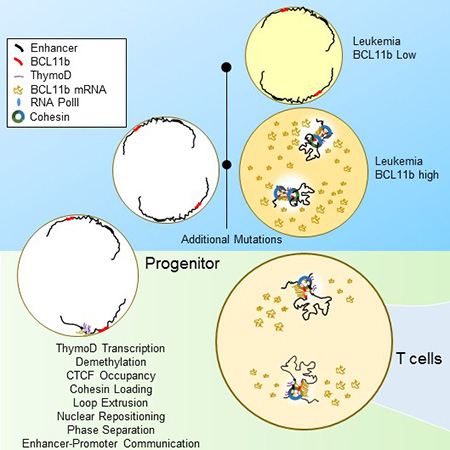
From Mario Aguilera at U San Diego News:
Intricate human physiological features such as the immune system require exquisite formation and timing to develop properly. Genetic elements must be activated at just the right moment, across vast distances of genomic space.
“Promoter” areas, locations where genes begin to be expressed, must be paired precisely with “enhancer” clusters, where cells mature to a targeted function. Faraway promoters must be brought in proximity with their enhancer counterparts, but how do they come together? When these elements are not in sync, diseases such as leukemia and lymphoma can result. How does this work?
Biologists at the University of California San Diego believe they have the answer.
Calling it the “big bang” of immune cell development, the researchers made their discovery within previously overlooked stretches of DNA located between genes. The results, published in the September 21 edition of the journal Cell, were led by Takeshi Isoda in Cornelis Murre’s laboratory in UC San Diego’s Division of Biological Sciences.
Through genomic studies and genetic experiments in mice, the scientists found that the ignored areas, known as “non-coding” DNA, activate a change in the 3D structure of DNA that brings promoters and enhancers together with stunning accuracy. Murre describes the mechanism as somewhat like a stiff wire—with enhancers and promoters on either end—that’s bended together into a loop and anchored in place. Enhancers and promoters, once distantly separated, are now repositioned in close proximity to initiate the development of immune system building blocks known as T cells.
…
“Nature is so clever. We think of the genome as an unstructured strand but in fact what we are seeing is a highly structured and meaningful design,” said Murre. “The process of architecture remodeling we’ve described allows the enhancer and promoter to find each other in 3D space at precisely the right time. The beauty is that it’s all very carefully orchestrated. We have seen one example but there are likely many others all occurring at the same time when cells are moving along the developmental pathway–that’s kind of amazing.” More.
 “Nature is so clever”? No, the programming that goes into nature is clever. See Evolutionary Informatics.
“Nature is so clever”? No, the programming that goes into nature is clever. See Evolutionary Informatics.
See also: Microprotein helps cells decide on best path to repair genes and avoid cancer
Researchers: Long-held view of cell division overturned (Transcription continues despite challenge during cell division.)